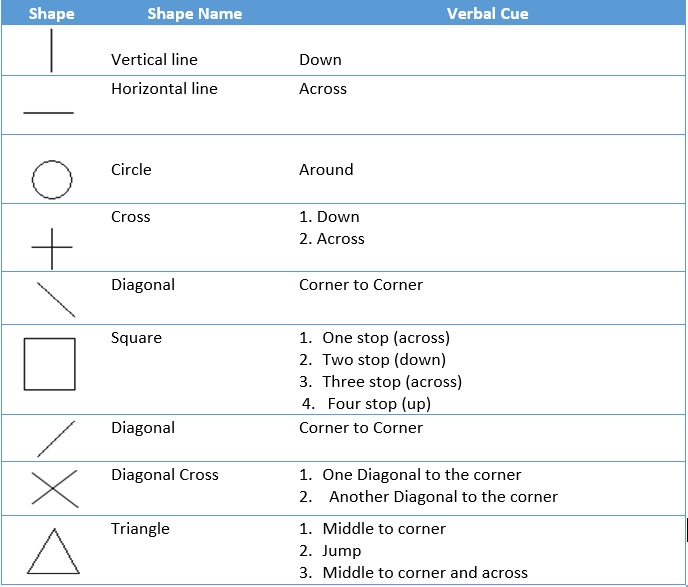Pre-writing
Handwriting is a complex skill that is learnt throughout a child’s development. From beginning to scribble as a young infant, to developing legible handwriting by the age of 7 years old to acquiring complex handwriting skills as a teenager (appropriate speed, flexibility in style etc.).
Consider first: Is the child’s writing ability in line with their cognitive development?
Developmental Stages in Acquiring Pre-writing Skills
Imitation – child is able to watch the adult making any marks.
Tracing – (some children omit this stage)
Copying – child receives no visual cues on how to make the mark produced by the adult.
These shapes underpin the main shapes used in printed and cursive script and the strokes are usually learned in the following order. The child may not have the developmental skills required for writing until he/she is able to copy all of these shapes.

These are activities to consider when addressing handwriting and use the principle that children with writing difficulties have got to over-learn the correct shape, direction and flow of their letters. Points to remember when working with the child on pre-writing shapes: Always remember to move gradually from large, whole body movements to smaller movements of the hand. When possible always work from – left to right, from top to bottom, anti-clockwise when doing circular movements.
They are particularly useful if the child doesn’t want to write.
Activities
- The Wet Dry Try Method
- Take a chalk board and make the shape on the board. Provide the child with a slightly wet/damp sponge and demonstrate and then ask them to ‘wet’ along/around the shape using their sponge. They should hold this between their thumb and index finger.
The sponge should be about the size of the box shown here, any bigger it will be hard for the child to hold it between his/her thumb and index finger. - Now provide the child with a dry piece of cloth of the same size and ask the child to dry along/around the shape they have just wet. Demonstrate this first.
- Now ask the child to try drawing the same shape on the chalkboard.
The Handwriting without tears Wet, Dry, Try app can also be used.
- Take a chalk board and make the shape on the board. Provide the child with a slightly wet/damp sponge and demonstrate and then ask them to ‘wet’ along/around the shape using their sponge. They should hold this between their thumb and index finger.
- Drawing lines in different textures: sand, rice, shaving-foam, finger-paint, hand cream, talcum-powder or gloop (corn flour and water mixture)
Put texture to be played with into the tray and encourage lines to be made with index finger of preferred hand; if there is no clear dominant hand allow either index finger to be used. Perhaps use a vertical surface such as a window or mirror. Remember to use the boundaries to help to make the shape. If you are able, repeat this activity with a couple of the textures. The more varied ways that a child ‘makes’ these shapes, the more chance they have of remembering it. - Ways of practising a circular movement:
Make a cake holding the bowl with one hand and stirring in a circular motion with the other hand. Draw in the air in an anti-clockwise movement with a scarf, long ribbon, paper-towel roll. Sing whilst doing action: ‘Draw a circle in the air, in the air. Draw a circle in the air, in the air. Draw a circle in the air and leave it hanging there, draw a circle in the air in the air.’ - Ways of making lines without drawing them:
Using material such as string, playdoh, plasticine and make the shapes or even lay the material over pictures of the shapes. Have him/her roll a car on a mat or picture of the shapes; drive the car along the roads and around the roundabouts on the mat. Try to ensure he/she does not move his/her body from one side of the mat to another, but rather uses his/her ‘driving’ hand in a variety of positions and crosses in front of their body. - Different ways to draw lines:
Have him/her paint the fence, wall or paving-slabs with water and a paintbrush.
Draw lines on different textures and in different plane (vertical and horizontal)
Use a variety of writing implements: pencil, crayons, wax crayons, chunky chalks, ordinary chalks, whiteboard markers, felt-tip pens, paintbrush, crayons. Try different textures to draw/paint on: sugar paper, chalkboard, pavement, bubble wrap, side of the bath, sandpaper, on long strips of lining wallpaper. Make the shapes out of sandpaper and mount on cardboard. Demonstrate and then ask the child, to run their index finger over the shape to ‘feel’ it. - Rainbow letters:
Adult draws a letter in one chalk colour, child copies in another colour, then repeat with other colours.
